------------------------------
1933-2006 ------------------------
The end for the Esquire Tavern came suddenly like the death of an old relative that you never even knew was sick. We always remember where we were when we receive news of a catastrophe; I got the bad news late in the afternoon, on a very hot day, at a mild, little watering hole called the Bar Lay Low.
“Did you hear the news?” the bartender asked me, as I was tipping into my third bottle of beer. “They’re going to close The Esquire. Tonight’s the last night”
“The hell you say,” I said, annoyed that anyone would even joke about such a thing. Sadly, though, it was not a joke. He produced an
article in the San Antonio Express News confirming that last call had indeed come for one of my closest, oldest, and dearest friends.
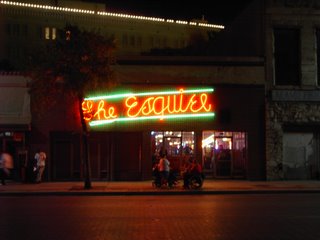
Without delay I gathered up some people and made the trip downtown to see the old haunt for the last time.
I do not remember the first time I ever went to the Esquire, but it it was probably sometme in 1976. Every time my grandfather took me with him on his downtown errands, and it was just the two of us, we seemed to end the day at The Esquire.
For many years after, it was the only place I could get an underage beer. They served me there because they knew my grandfather. Even after he passed away, in 1988, I could still drink there without hassle, as long as I sat at the last booth in the back, so that I could slip out the back door to the Riverwalk, if the authorities walked in the front door. The never did.
It was strange, that night, walking through those greasy front doors, on 155 E. Commerce St, knowing it was going to be for the last time; Those doors that had offered warm, welcoming, shelter to generations of San Antonians, and visitors from afar, since 1933. To the left is the longest long bar in the State of Texas, stretching almost the entire length of the room.

On the right, the row of high backed wooden booths that had offered me anonymity and safety, were all filled up. We had to wedge ourselves into the crowded bar, amid the regulars and fans, and the gawkwers that had come to watch the old place go down in style.
After talking to a few people, I found out that the two fat-cat grossero owners, who had bought the bar out from under the original owner 15 years ago, had, at last tired of the place, and had decided to rape it for her charms, dress her up and pimp her out as a trendy trap for the tourists. Blame it on the Riverwalk Expansion Project, on progress and on greed.
Whatever the reasons, it was evident, that nght, that The Esquire was making her last stand.
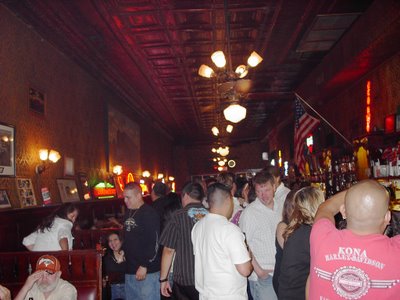
"They're keeping the light fixtures and the bar, I think," said one patron. "But I think they're going to rip out the wall-paper and paint over the murals."
The cieling, I found out, is also going to be kept. It's a wonderful goddamn coffered thing, a real work of art, the kind of thing that makes it look like a real saloon. Photgraphs don't really do the wall-paper justice, but that too is part of the whole Old West Saloon feel. It's textured and old and, when you touch it, it feels like touching the past.
"I offered to buy one of those lamps on the wall," he went on. "But the they won't sell me one." He took a deep swallow off his longneck beer. "I'm going to steal one when no one's looking," he chuckled.

The jukebox was playing something up-beat, and there was a band setting up in the back, so we stood at the bar drinking beers , with an occasional shot of tequila or bourbon, to mark the passing of a landmark, trying hard to forget how fast the clock was moving.
We should always be aware of the mortality of our favorite places, the intense fragility of a time and a place, but one expects a certain level of venerability of such a thing as an old bar. When one of them is taken from you it strikes you hard, and leaves you feeling stunned and hollow, like when you give it your all, and you still coming up one run short.
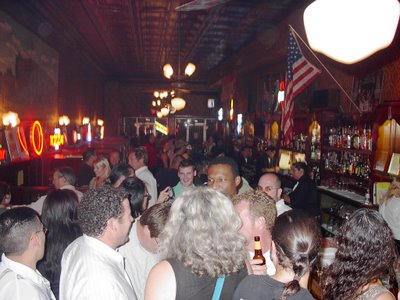
News of such a calamity hits different people in different ways; Some of them weep openly, others enter into a state of denial, and still others stoically belly up to the bar and take part in the age old ritual known as The Wake, wherein fond memories and bitter-sweet recollections are passed around like an open bottle. Pain shared is pain lessened, as the old bar room adage goes.
A booth opened up and my party went to sit there, but I stayed at the long bar, talking to Joe Anthony, who was so proud of having just been interviewed by someone for the Express News. He told me how he remembered coming to the bar with his mother, when he was a child, and raising cain until she took him to the long gone Woolworths down the block to buy him a toy. "I'll still keep coming here when they reopen it. It's the only bar I haven't been thrown out of," he chucked. "And I've been thrown out of lots of bars."

I won't be back. A few years ago, I had a friend come all the way from Tasmania to visit. For most of her trip, she found some way to unfavorably compare things to her country. Now, it’s always been my habit to take tourists and friends from My Famous Alamo Tour to the San Fernando Cathedral by way of The Esquire. It’s right along the path, from either the Riverwalk or on the street level.
With her, I cut the Alamo tour short, and herded her into one of those tall wooden booths, where for the next two hours, she sat likea child, gazing at the place in wonder, drinking cold beers, and rolling her own cigarettes, finally giving me the satisfaction of hearing her say “We have *nothing* like this back home.”
How can I top a compliment like that in what is going to becom a "Family Friendly Atmosphere"?
No. I won't be back.
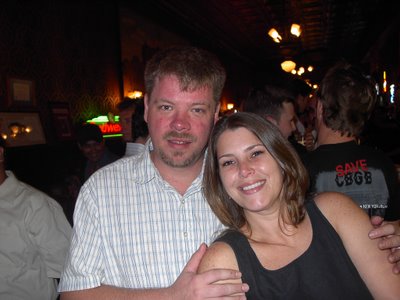
A little later I was at the bar, alone by that point because a booth had finally opened up and my party had moved there wthout me; I was trying to get a bartenders eye when I met a lovely young couple from Houston. They were intensly absorbed by the extra innings of the Houston v. Pittsburgh game (Go Astros!), and I struck up a conversation with them. It turned out that they just needed to get away, came down to San Antonio, and had found the bar by accident. He lamented The Esquires fate, correctly blaming it on “the yuppies”. It turns out that the same thing is going on in Houston, the "trendification" of historic sections of town, sacrificing historical value for the mighty tourist dollar. I was glad that, even on her last night as a Real Bar, The Esquire could still pull them in from near and far.
I stood there, at the bar, glad to be there, in that time and at that moment, letting my hands drink in, for the last time, the rough-hewn, age-worn wood on the lip of the bar, as if I could, somehow, infuse myself with the power of the place, take it with me when I left, and carry it forever.
Years ago, I remember that, in cowboy movies, I’d seen men step up to a bar and order a shot of whiskey, toss it back with a well-practied grace, then flip some money on to the counter and just walk out. Even in Cairo, where I honed my drinking skills to a near expert level, I had never had occasion to do that. So, one afternoon, not long after my return to San Antonio from Berkeley, after a particularly sour date, I walked in to The Esquire, feeling low, and ordered a double shot of Wild Turkey. I swigged it down and paid before the bartender could even blink; an then I turned around and just walked out of there, without a care in the world, feeling like Jesse James. It's not something that I do often, nor is it something that I recommend for the faint of liver or will, but I do think everyone should do it, at least once.

Later that night, sitting alone in a booth, listening to the loud rockabilly stylings of Mitch Webb and the Swindlers, I thought about some of the musicians I'd met there, over the years.
The Esquire was never much known for being a music venue. Live music is not a staple,anymore, in such a narrow and enclosed space, but I could list some names that played there that have shaken the pillars of heaven and hell with their music. Legends whose songs still move with me, and will always be part of the sountrack to my life. To not only have heard their music and met them, but to have sat dowen there and shared a beer with them, talked to them. That's a rare and special gift that will not come that easily again.
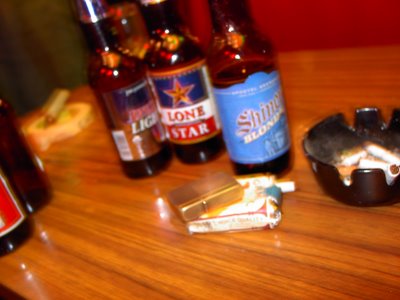
Some of them are dead already, and some of them are on their merry way, but for me, they will never sound as good as they did when heard from one of those tall wooden booths in that long narrow room, a cold beer in one hand and a cigarette in the other. Maybe that's the way way it'll be when I get to where some of them they're at, if and when I get there; Maybe they'll sound just as good as they did back then, but I have a feeling that, for it to be anywhere near as good, it will have to look and feel a lot like The Esquire.
As one patron said that night : "Damnit, if they take away The Esquire, where the hell is Jesus going to get a drink when he comes back?"
I had been there for a few hours, that final night, roping up memories like stray cattle, and drinking beer like it would actually do some
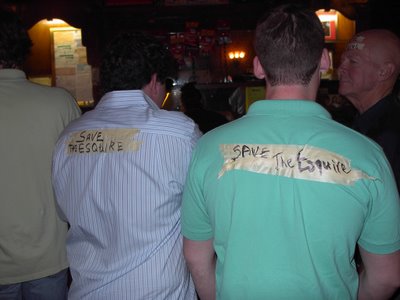
good, when I noticed several people wandering around the bar with bits of masking tape adhered to themselves. They had written little messages on them in support of preserving the old place, and it was pleasant to see them doing this, as they all seemed to be really into the idea of saving The Esquire; but I felt it was too little too late. Where were they when the plans to shut her down were announced? Where were they when it really mattered?
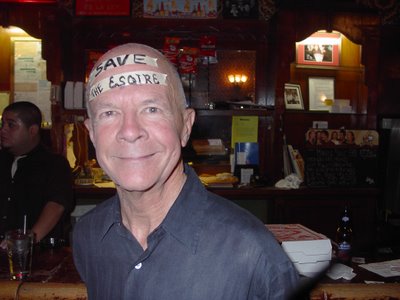
To be fair, however, if the gant-hawk owners had bothered to let the people know of their intentions ahead of time, I like to think that these people could have mounted one of those industriously
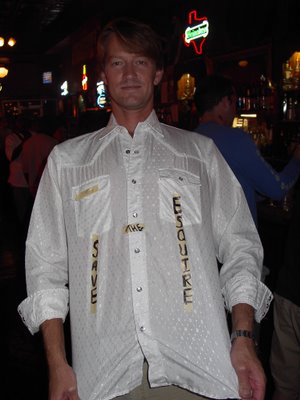
futile, grass-roots, kind of movements to try and Save the Esquire, the way they do in cities that actually give a rats fat ass about heritage and history. Maybe it would have gained some support from the city drunks, maybe even from the old timers at the court house across the street, the ones that used to wander in for a lunchtime triple shot and an ice cold bottle of beer. Maybe it might have acvtually done some good. Unfortunatly, however, all we had left to offer
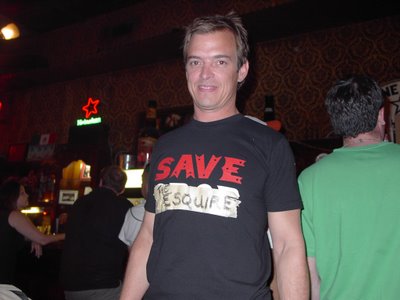
were little ticky-tacky scraps of tape with which to offer feeble support for a cause that was lame from the moment it left the gate. I noticed that hardly, if any, of the actual regulars had tape stuck to themselves.

Certainly none of the Staff did.
In fact, I noticed that the staff seemed quite surley and bothered by the fuss. Maybe it was the crowd, the rush for .75 cent beer, that made them cranky, or maybe it was that they felt the loss in a very personal and deep way that they chose not to share with the public on the opposite end othe bar; I did notice that the moment was not wasted on all of them, however, that at least one of them took the time to take a picture of the crowd, with which to pad her deposit of memories.
After seeing the little strips of tape everywhere, I had to go in search of the people that were scribbling these tags, fighting, it were, The Good Fight. I couldn't confrim that they came up with the idea, but I was led to this couple with the roll of tape and a black felt-tip marker. It seems that they had moved back to their native San Antonio from San Franciso, had found out the terrible news in much the same way as I, and had to hurry down to the bar to give it their own farewell.
I with them a while and reminisced with them about the Place, and talked about some good times I'd had in the Bay Area but, after a round of drinks, I realized that they were not at all the type of people who would have ventured out of the City unless they had to, or into the DMZ that is Oakland, and certainly not into Connolly's Tavern on Telegraph Ave. It just wasn't their thing, and certainly not their kind of place; neither,
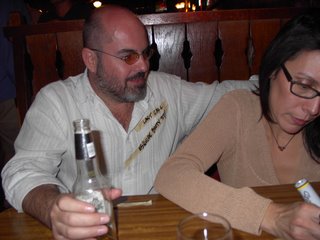
for that matter, was The Esquire.
I remember when The Esquire carried a certain kind of seedy respect, when it was the kind of joint that you didn't take a respectable date, where, by just walking into the place, you were taking your life into your own hands. The Esquire always had a shady, sort of rough reputation. In its 73 years of business, more than a few patrons came to a quick and messy end, mid-swig and unaware. This prompted the management to hire security to frisk patrons at the door.
One chilly night, in December of 1999, I went in dressed in my winter long coat, tall combat boots, mirror shades, and black leather gloves; the young, plump, security guard saw me coming and was suddenly busy elsewhere. Since I wasn’t frisked, the entire front section of the bar moved closer to the back door, and every conversation stopped when I settled in for a drink. For the duration of three beers and four shots, I generated enough nervous energy in those people to launch the space shuttle.
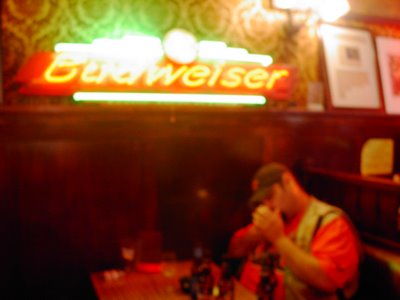
Being a total nerd, however, I was oblivious to this until my uncle told me, later, that they thought I was going in there to take some one out; they thought it was a hit. That's the kind of place The Esquire was, once.
There were no yuppies in the bar, back then, and people didn't think it was trendy to go there; Back then, they hadn't yet built up the balls to slum it in that side of town.
I think of all the good places, here in San Antonio, that have slowly been infested by the young and terminally fashionable, the altogether-clueless droves: the Bar America, and the Mission Drive-In, the entire south side of downtown, and I suddenly don't feel so bad about how The Esquire went out.
She didn't have a chance to be taken over by yuppies or poseurs, or the fraudulently cool, like so many other old venues in this town. Whatever they open up in her place might have the same name, but the intention was made clear already to make it a "family BBQ" establishment. In other words, She's dead and nothing can change that, but at least she didn't fizzle, reek, and fester in the throes of transition; at least she didn't get squashed by the invasion of the chic.
My grandfather went out the same way, a relic from a different age. The weekend he died, he went partying on friday night, saturday night he went out with his girlfriend, and then to church on sunday morning. That night he took me in his arms and gave me a monsterous bear hug that made my spine crack, and it was strong, and memorable, and forever. Monday by noon-time, he was dead. Just like that. No illness, no worry, and no fear. That's the way I'd like to go.
I'm glad that he went out that way, and in the same way, I am glad that The Esquire went out the way she did, too. We should all be so lucky.



 Without delay I gathered up some people and made the trip downtown to see the old haunt for the last time.
Without delay I gathered up some people and made the trip downtown to see the old haunt for the last time. On the right, the row of high backed wooden booths that had offered me anonymity and safety, were all filled up. We had to wedge ourselves into the crowded bar, amid the regulars and fans, and the gawkwers that had come to watch the old place go down in style.
On the right, the row of high backed wooden booths that had offered me anonymity and safety, were all filled up. We had to wedge ourselves into the crowded bar, amid the regulars and fans, and the gawkwers that had come to watch the old place go down in style. "They're keeping the light fixtures and the bar, I think," said one patron. "But I think they're going to rip out the wall-paper and paint over the murals."
"They're keeping the light fixtures and the bar, I think," said one patron. "But I think they're going to rip out the wall-paper and paint over the murals." The jukebox was playing something up-beat, and there was a band setting up in the back, so we stood at the bar drinking beers , with an occasional shot of tequila or bourbon, to mark the passing of a landmark, trying hard to forget how fast the clock was moving.
The jukebox was playing something up-beat, and there was a band setting up in the back, so we stood at the bar drinking beers , with an occasional shot of tequila or bourbon, to mark the passing of a landmark, trying hard to forget how fast the clock was moving.


 Later that night, sitting alone in a booth, listening to the loud rockabilly stylings of Mitch Webb and the Swindlers, I thought about some of the musicians I'd met there, over the years.
Later that night, sitting alone in a booth, listening to the loud rockabilly stylings of Mitch Webb and the Swindlers, I thought about some of the musicians I'd met there, over the years. Some of them are dead already, and some of them are on their merry way, but for me, they will never sound as good as they did when heard from one of those tall wooden booths in that long narrow room, a cold beer in one hand and a cigarette in the other. Maybe that's the way way it'll be when I get to where some of them they're at, if and when I get there; Maybe they'll sound just as good as they did back then, but I have a feeling that, for it to be anywhere near as good, it will have to look and feel a lot like The Esquire.
Some of them are dead already, and some of them are on their merry way, but for me, they will never sound as good as they did when heard from one of those tall wooden booths in that long narrow room, a cold beer in one hand and a cigarette in the other. Maybe that's the way way it'll be when I get to where some of them they're at, if and when I get there; Maybe they'll sound just as good as they did back then, but I have a feeling that, for it to be anywhere near as good, it will have to look and feel a lot like The Esquire. good, when I noticed several people wandering around the bar with bits of masking tape adhered to themselves. They had written little messages on them in support of preserving the old place, and it was pleasant to see them doing this, as they all seemed to be really into the idea of saving The Esquire; but I felt it was too little too late. Where were they when the plans to shut her down were announced? Where were they when it really mattered?
good, when I noticed several people wandering around the bar with bits of masking tape adhered to themselves. They had written little messages on them in support of preserving the old place, and it was pleasant to see them doing this, as they all seemed to be really into the idea of saving The Esquire; but I felt it was too little too late. Where were they when the plans to shut her down were announced? Where were they when it really mattered?
 futile, grass-roots, kind of movements to try and Save the Esquire, the way they do in cities that actually give a rats fat ass about heritage and history. Maybe it would have gained some support from the city drunks, maybe even from the old timers at the court house across the street, the ones that used to wander in for a lunchtime triple shot and an ice cold bottle of beer. Maybe it might have acvtually done some good. Unfortunatly, however, all we had left to offer
futile, grass-roots, kind of movements to try and Save the Esquire, the way they do in cities that actually give a rats fat ass about heritage and history. Maybe it would have gained some support from the city drunks, maybe even from the old timers at the court house across the street, the ones that used to wander in for a lunchtime triple shot and an ice cold bottle of beer. Maybe it might have acvtually done some good. Unfortunatly, however, all we had left to offer were little ticky-tacky scraps of tape with which to offer feeble support for a cause that was lame from the moment it left the gate. I noticed that hardly, if any, of the actual regulars had tape stuck to themselves.
were little ticky-tacky scraps of tape with which to offer feeble support for a cause that was lame from the moment it left the gate. I noticed that hardly, if any, of the actual regulars had tape stuck to themselves.  Certainly none of the Staff did.
Certainly none of the Staff did. for that matter, was The Esquire.
for that matter, was The Esquire. Being a total nerd, however, I was oblivious to this until my uncle told me, later, that they thought I was going in there to take some one out; they thought it was a hit. That's the kind of place The Esquire was, once.
Being a total nerd, however, I was oblivious to this until my uncle told me, later, that they thought I was going in there to take some one out; they thought it was a hit. That's the kind of place The Esquire was, once.